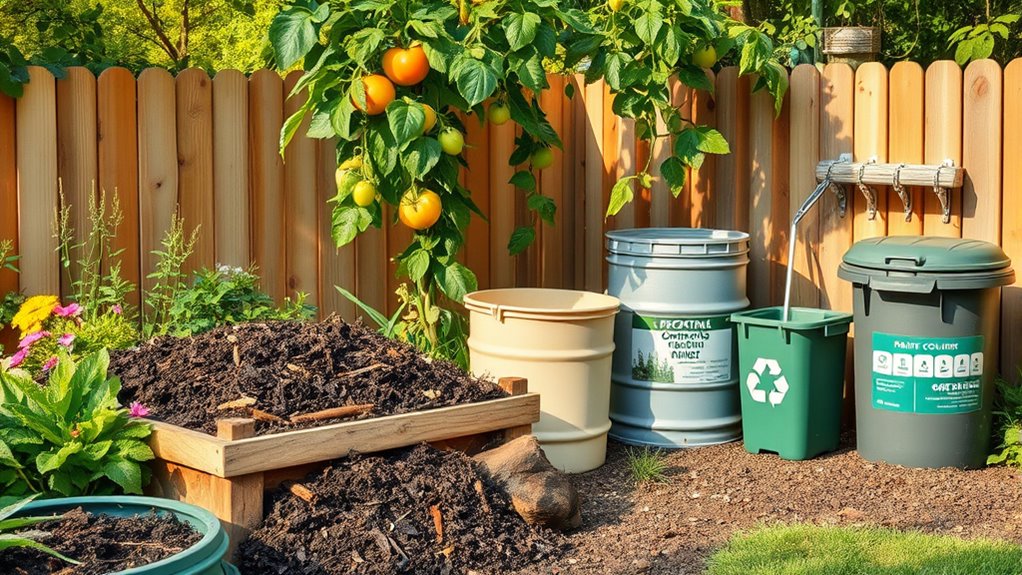Zero-waste gardening involves turning organic waste into valuable garden resources through composting and recycling. You can start by using simple methods like bin composting or worm farms to turn kitchen scraps and yard waste into nutrient-rich soil. Balancing green and brown materials, aerating regularly, and choosing eco-friendly setups help speed up the process. By practicing these techniques, you’ll create a sustainable, healthy garden—continue exploring for more tips to master zero-waste gardening at home.
Key Takeaways
- Compost kitchen scraps and yard waste to create nutrient-rich soil, reducing garden waste and reliance on chemical fertilizers.
- Use simple composting methods like bin composting or worm farms for easy at-home waste recycling.
- Maintain proper green and brown material balance and aerate regularly to speed up compost decomposition.
- Incorporate compost into garden beds to improve soil health, promote biodiversity, and support resilient plant growth.
- Embrace circular resource practices by turning waste into valuable garden resources, reducing landfill contributions.

Zero-waste gardening is a sustainable approach that minimizes waste and maximizes resource efficiency in your garden. By adopting effective composting techniques, you turn kitchen scraps and garden waste into nutrient-rich soil, reducing the need for chemical fertilizers and decreasing landfill contributions. Composting not only recycles organic material but also enhances your soil’s health, supporting sustainable planting practices that promote biodiversity and resilience. You can start with simple methods like bin composting or worm farms, making it easy to manage waste and create compost at home. Regularly add kitchen peelings, coffee grounds, eggshells, and yard trimmings, ensuring you balance green and brown materials for ideal decomposition. Turning or aerating your compost pile helps maintain airflow and speeds up the process, so you’ll have nutritious compost ready in a few months. This approach encourages a circular cycle where waste becomes a valuable resource, aligning perfectly with the principles of zero-waste gardening. Additionally, understanding aura colors and their meanings can promote emotional well-being and mindfulness, which enhances your connection to nature and your garden space.
Frequently Asked Questions
How Can I Start Composting in a Small Apartment?
You can start composting in a small apartment by setting up indoor composting. First, choose a suitable container—look for a compact, odor-proof bin with good ventilation. Place it in your kitchen or a discreet spot. Regularly add kitchen scraps like vegetable peels and coffee grounds, and turn the compost occasionally. This way, you reduce waste and create nutrient-rich compost without needing outdoor space.
What Are Common Composting Mistakes to Avoid?
You might find it surprising, but avoiding common composting mistakes helps prevent odors and keeps your compost bin healthy. Make sure you balance greens and browns, and don’t overfill it. Regular maintenance is key—stir the compost and monitor moisture levels. Neglecting bin maintenance can cause odors and slow decomposition. Keep an eye on airflow, and avoid adding meat or dairy, which can attract pests and cause unpleasant smells.
How Long Does It Take for Compost to Be Ready?
It typically takes 3 to 6 months for compost to be ready, depending on factors like compost temperature and soil nutrients. You’ll notice it’s finished when it’s dark, crumbly, and earthy smelling. To speed up the process, turn your pile regularly and keep it moist. Proper aeration and balancing greens and browns help maintain ideal compost temperature, ensuring faster, nutrient-rich compost for your garden.
Can I Compost All Kitchen Scraps?
You can compost most kitchen scraps, but avoid adding meat, dairy, and oily foods since they attract garden pests. To keep your compost healthy, monitor the compost temperature; it should stay between 135-160°F to decompose efficiently and prevent pests. Regularly turning your compost helps maintain this temperature and ensures good airflow, making your scraps break down faster into rich, usable compost for your garden.
What Recycling Programs Are Available for Garden Plastics?
You can find recycling programs for garden plastics at local recycling drop-off locations. These programs typically accept garden plastic types like plant containers, pots, and trellises. Check with your city or waste management services to find nearby drop-off sites. Some programs even accept larger garden plastics, ensuring you dispose of your garden plastics responsibly and keep your yard eco-friendly. Always verify which garden plastics are accepted beforehand.
Conclusion
By embracing zero-waste gardening, you’re not just recycling scraps—you’re transforming your backyard into a lush, self-sustaining paradise that could rival nature’s most breathtaking landscapes. Imagine your garden bursting with vibrant life, all powered by your commitment to compost and reuse. Every peel, leaf, and scrap becomes a miracle of rebirth, turning your tiny patch into a thriving oasis so incredible, it’ll make the world’s grandest gardens look dull in comparison.









